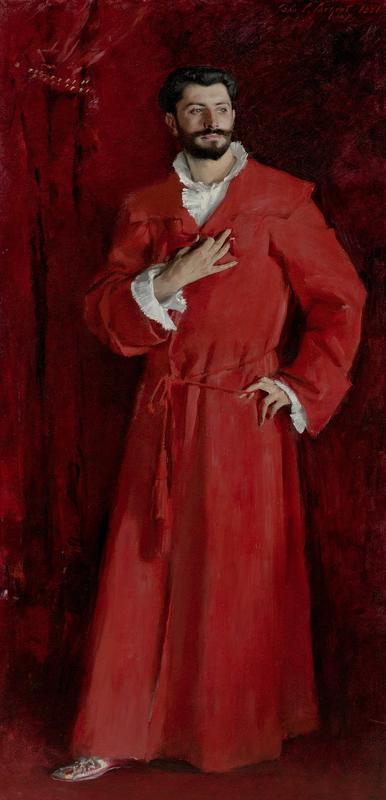More about Dr. Pozzi at Home

Sr. Contributor
Dr. Pozzi at Home is a portrait with all the casual aesthetic of a Victoria’s Secret ad.
Despite being called Dr. Pozzi at Home, there’s not much of a domestic quality to the piece. To be fair, it was originally just called A Portrait. There’s several reasons behind the sensuality of this painting and other conflicting theories besides.
Our artist, John Singer Sargent, took some inspiration from Velázquez after a trip to Spain. He opted for red-on-red to portray his subject here, his subject being Dr. Samuel Jean de Pozzi, a famous pioneer in the field of gynecology. Also known by other titles such as “The Siren” or “Doctor Love," Pozzi also called “himself a kind of beautiful work of art.” So, Sargent's enduring historical portrait isn’t focused so much on the advances he made in medicine, but on how freakishly handsome Pozzi was. Hence the passionate red hues and the dramatic, lavish attire.
Sargent and Dr. Pozzi were friends, but some have suggested the sensuality of this portrait stems from a homoerotic admiration. Those who suggest this typically point to the fingers as the sensual focal point of the painting, noting all the extra detail and care taken into rendering them. Others argue this extra focus was actually meant to emphasize Dr. Pozzi’s surgical prowess. But everyone tends to agree they’re the sexiest part of the piece.
Others intent on unearthing an even more juicy scandals have suggested the sensuality ties it to another of Sargent’s pieces, his most controversial: Madame X. In that painting, Sargent depicts a Parisian socialite with a modern air of unabashed sexuality...and everyone hated it. Nevermind all the mythical subjects used as excuses for blatant nudity, it’s a woman appearing self-confident in her sexuality that offended their oh-so-delicate sensibilities.
Over the years, it wasn’t uncommon for Madame X and Dr. Pozzi at Home to be placed on display right next to each other. So, with rather little evidence, it was suggested that the two had an affair in real life. They did exchange a few letters, and she was invited over for tea with his pregnant wife at one point. Apparently, the author who was the first to suggest their scandalous association didn’t even know Dr. Pozzi was married.
That’s not to say Dr. Pozzi was actually loyal to his wife. He wasn’t just known for being handsome, but also had a reputation for sleeping around. Several writers claim the unhappiness of their marriage stemmed from his wife’s insistence on having her mother live with them. Dr. Pozzi supposedly had to battle his mother-in-law for his wife’s affections, but surely proper communication was always an option over cheating.
Despite his social reputation and extramarital drama, Dr. Pozzi was highly regarded throughout his career. He often traveled abroad to bring gynecological techniques from Germany and Austria, writing a full textbook on his findings. He was known for taking care of his female patients by putting them at ease and keeping their emotional wellbeing into account. He remained friends with Sargent after sitting for this portrait, and was in possession of Madame Gautreau Drinking a Toast when he died. Amélie Gautreau is Madame X’s real name, but that’s still little evidence of a love affair.
Sadly Dr. Samuel Jean de Pozzi, after enjoying a long career, was murdered in his office. You might guess it was a jealous ex-lover or a spurned husband who shot him, but it was actually a past patient who blamed “Doctor Love” for his impotence. Reportedly, Dr. Pozzi gave the doctors who were operating on him after the shooting words of advice and encouragement, but to no avail.
Sources
- Bellow, Juliet. “The Doctor Is In.” American Art 26, no. 2 (2012): 42–67. https://doi.org/ 10.1086/667950.
- Costa, Caroline de, and Francesca Miller. The Diva and Doctor God: Letters from Sarah Bernhardt to Doctor Samuel Pozzi. Bloomington: Xlibris Corporation, 2010.
- Cozzi, Leslie. “Dr. Pozzi Comes Home.” Hammer Museum, October 7, 2014. https://hammer .ucla.edu/blog/2014/10/dr-pozzi-comes-home.
- Davis, Deborah. Strapless: John Singer Sargent and the Fall of Madame X. Stroud: Sutton, 2004.
- “Dr. Pozzi at Home.” Metmuseum.org. Accessed February 18, 2022. https://www.metmuseum .org/art/collection/search/644345.
- Karamanou, Marianna, Achilleas Drogosis, Nikolaos Salakos, Kostas Markatos, Efthimios Deligeoroglou, and George Androutsos. “Cervical Cancer in the Work of the Unconventional ... - JBUON.” Accessed February 18, 2022. https://jbuon.com/archive /23-1-279.pdf.
- Nevins, Michael A. Meanderings in Medical History Book Four. Bloomington, IN: iUniverse, Inc., 2016.
- Sandefur, Timothy. “John Singer Sargent and the Art of Elegance.” The Objective Standard, August 20, 2020. https://theobjectivestandard.com/2020/08/john-singer-sargent-and -the-art-of-elegance/.
- Simpson, Marc. Uncanny Spectacle: The Public Career of the Young John Singer Sargent Published on the Occasion of the Exhibition Held at Sterling and Francine Clark Art Institute, 15 June - 7 September 1997. Yale University Press, 1997.
Featured Content
Here is what Wikipedia says about Dr. Pozzi at Home

Dr Pozzi at Home is an 1881 oil painting by the American artist John Singer Sargent. The portrait of the French gynaecologist and art collector Samuel Jean de Pozzi was Sargent's first large portrait of a male subject: it measures 201.6 cm × 102.2 cm (6 ft 7.4 in × 3 ft 4.2 in). It was the first work that Sargent exhibited at the Royal Academy in London. It was acquired by Armand Hammer in 1967, and has been held by the Hammer Museum in Los Angeles since 1991.
Check out the full Wikipedia article about Dr. Pozzi at Home












